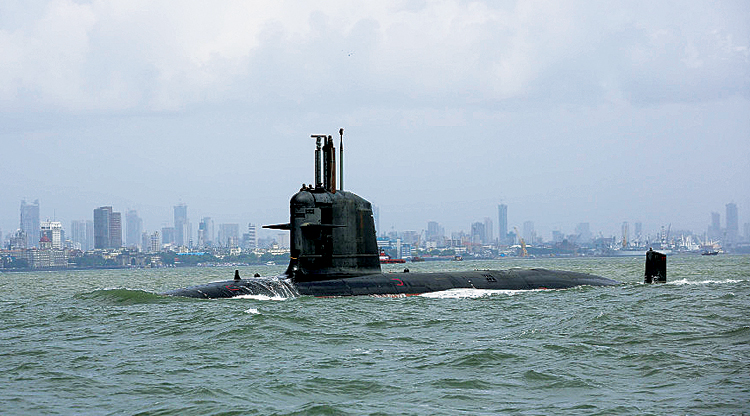INDIAN ARMED FORCES CHIEFS ON OUR RELENTLESS AND FOCUSED PUBLISHING EFFORTS

The insightful articles, inspiring narrations and analytical perspectives presented by the Editorial Team, establish an alluring connect with the reader. My compliments and best wishes to SP Guide Publications.

"Over the past 60 years, the growth of SP Guide Publications has mirrored the rising stature of Indian Navy. Its well-researched and informative magazines on Defence and Aerospace sector have served to shape an educated opinion of our military personnel, policy makers and the public alike. I wish SP's Publication team continued success, fair winds and following seas in all future endeavour!"

Since, its inception in 1964, SP Guide Publications has consistently demonstrated commitment to high-quality journalism in the aerospace and defence sectors, earning a well-deserved reputation as Asia's largest media house in this domain. I wish SP Guide Publications continued success in its pursuit of excellence.
- MoD initiates comprehensive review of Defence Acquisition Procedure 2020, pushes for defence reforms
- G7: The Swansong
- Kalinga Connect: South Asia to Polynesia
- Advanced MRSAM for India for a greater firepower
- Must Credit DRDO for Operation Sindoor, now what is next for defence R&D?
- Operation Sindoor | Day 2 DGMOs Briefing
- Operation Sindoor: Resolute yet Restrained
LEAD STORY
Indian Navy Submarine Force – Way Ahead
We have been exposed to German, French and Russian submarine design and build philosophy, therefore the need of the hour is to have an Indian design and build philosophy to take forward indigenous submarine building programme
 | The author is former Chief of the Naval Staff (CNS) of Indian Navy. During his tenure as the CNS, he also served as Chairman of the Chiefs of Staff Committee. He retired on May 31, 2019. The Admiral is currently the Chairman of National Maritime Foundation. |

The submarine is the single most powerful piece of military hardware ever devised. Inside the hull of a single nuclear ballistic missile boat is more firepower than any other platform. Submarines have played a key role since their induction and deployment in World War 1, and in today’s uncertain world they have an even more important role to play.
Role of Submarines
The essence of a submarine is their ability to silently cruise hundreds of feet below the surface of the water unseen and undetected. ‘Stealth’ conjures up images of futuristic aircraft that can evade radar, submarine development has been driven by a quest for stealth. In many ways, the submarine is the opposite of the surface ship. An aircraft carrier gains its strength from being visible, the submarine from being invisible. The carrier can show the flag, make a nation’s presence known, act as a show of force, or display support via a friendly visit. The submarine, on the other hand, is discreet. It can be quietly dispatched to keep an eye on things or it can apply pressure without being overt. This stealth allows a submarine to put a massive amount of uncertainty into the mind of an enemy. The sinking of Argentine cruiser the General Belgrano by HMS Conqueror during the Falkland War in 1982, kept the Argentine fleet bottled up in port. Thus a modern submarine is a multi-role platform with its primary mission being of Sea Denial. They can conduct both overt and covert operations. It is an ideal platform for surveillance and information gathering operations off hostile shores. Now modern submarines also have the capability to address targets ashore with Land Attack Missiles.
Submarine Building in India
The Indian Navy submarine arm enjoys a history of 55 years with the first boat INS Kalavari a Soviet Foxtrot Class submarine being commissioned on December 8, 1967. Four boats where acquired between 1967 and 1969 and another four followed between 1972 and 1974. There was a gap of over a decade before a new class of boats were inducted into the Navy. A total of 14 boats of two different classes were inducted between 1986 and 2000. They were 10 Kilo Class from Russia and 4 Type 209 from Germany. Two of the four Type 209 were built in India at Mazagon Dockyard Ltd in Mumbai. With the construction of two Type 209 boats an indigenous capability and capacity of a submarine building line was developed at great cost and constituted an important landmark in India’s goal of becoming builder’s navy. But unfortunately after construction of just two submarines at the building line at Mazagon Dock Limited (MDL), no follow on orders were placed and the yards lost all its highly skilled and trained man power, with the building line unutilised.

In 1999 the Government approved a 30 year programme for a force of 24 conventional submarines for the Navy. This has been modified to 18 conventional plus six nuclear powered (SSN) boats. The submarine building plan consisted of, six Project 75, followed by six Project 75(I) and six Project 76 conventional submarines. The plan was to build capability through Project 75 and 75(I) by transfer of technology to be able to design and build submarine. Project 76 is to be an Indian designed submarine. Both Project 75(I) and Project 76 are to be with AIP system. Unfortunately the 30 year programme is running way behind schedule by over 20 years. Since 1999, the plan has only delivered five Scorpene class submarine of Project 75. The Project 75, being executed by Mazagaon Dock Limited along with their French partner Naval Group suffered delay in award and thereafter in execution of about a decade in delivery of the boats. Five of the six submarines have been commissioned till date. The last boat has been launched in April 2022 with its commissioning slated in early 2023. But history is being repeated once again at Mazagon Dockyards, with the fabrication department of the submarine building line once again sitting ideal for the past few years after the hulls of the six Scorpene were completed over four years ago. Skill set of welder are lost quickly and they would need to be retrained all over again if Mazagoan Dockyard is awarded new submarine contract. We cannot keep repeating the same mistake of letting this strategic asset go to waste without further orders.
Project 75 India
Project 75(I) has had its own share of ups and down. In 2016 the Project was made part of the new Strategic Partnership Model for major projects to be executed by the Private Sector. The SOP for the SP model itself took over two years to be promulgated. Thereafter a committee was set up to identify shipyards which have the capability to construct submarines. In January 2020, two shipyards L&T and Mazagaon Dock Limited were shortlisted as Indian partners for the project. Five foreign OEMs shortlisted for the Project include Daewoo Shipbuilding & Marine Engineering (South Korea), Naval Group (France), Navantia (Spain), Rosoboronexport (Russia) and ThyssenKrupp Marine Systems - TKMS (Germany). The Request for Proposal (RFP) was issued to the shortlisted Strategic Partners MDL and L&T in July 2021 with responses due in November 2021. This however was too short a period for the Yards, as they have to identify the OEM and there after negotiate and submit their bids. The date of submission was extended to June 2022. The NSQR requires a proven fuel cell AIP equipped submarine. Rosoboronexport, Naval Group and Navantia do not have a proven fuel cell AIP equipped boat. Which leave TKMS and Daewoo in the fray. TKMS also has apprehension on technology transfer and extended liability clauses. This being the first SP case for a major ship/submarine construction project, the whole approval process has also taken a prolonged time leading to delays in the project.
The DRDO project to develop an indigenous fuel cell AIP is also running way behind schedule and the DRDO AIP is yet to pass shore base trails
The DRDO project to develop an indigenous fuel cell AIP is also running way behind schedule. In the original scheme of thing it should have been developed, tested ashore and a plug ready to be fitted in the final two boats of the Scropene class. But despite of the delay in the construction of the Scropene class, the DRDO AIP is yet to pass shore base trails. If timelines had been met, then there would have been a proven Indian AIP Plug available to be fitted. Now there is also the challenge to find a submarine platform for the DRDO AIP to be fitted in and to prove it at sea. The Navy can ill afford to provide a submarine from its depleted force level of conventional submarines.
The 30 year plan approved in 1999 has been poorly executed with delay in decision making and linking submarine construction to the new Strategic Partnership Model. The Nation has set up two submarine construction line in the country at great cost. The conventional submarine at Mazagoan Dockyard and nuclear powered boats at SBC Visakhapatnam along with its partner L&T. The decision would be to designate MDL for conventional submarines and, SBC and L&T for Nuclear powered boats. The delay in execution of the 30 year plan, has seen steady fall in submarine force level and obsolescence of platforms. To arrest the fall in numbers, the Navy has been forced to undertake second life certification of few of the submarine to extend their life beyond 30 years.
Way Forward
The Navy had hoped that timely signing of contract for Project 75(I) would have arrested falling force level and optimum utilisation of submarine construction facilities. Policy changes and lack of timely decision making has delayed the launch of the project by over a decade. As mention above, the way ahead is to designate MDL as the Strategic Partner for conventional boats. TKMS and Daewoo are the only two OEMs with a proven fuel cell AIP equipped submarine. To select the OEM for the project, the way ahead is for Government to Government negotiation with South Korea and Germany to select the OEM, fix the technology transfer level and liability clauses. Otherwise there will be further delays in signing of the contract and submarine force level will fall further below the current level of 17 submarines.
Submarines are the most complex platform that are built in the world. They are a complex integration of, high tech steel/other material, very stringent structural standard, engineering, electrical and electronic system which are specifically designed for and fitted for in a submarine. To take indigenous conventional submarine construction forward we also need to develop industrial capacity and capability to support design and construction of submarine with in the country. We also need to adopt a design and build philosophy to consolidate submarine building in the nation. At the moment we have been exposed to German, French and Russian design and build philosophy, therefore the need of the hour is to have an Indian design and build philosophy to take forward indigenous submarine building programme. The Project 75(I) envisages transfer of knowhow and know why of the submarine design and construction. The need of the hour is timely decision making to take the 30 year submarine programme forward.





